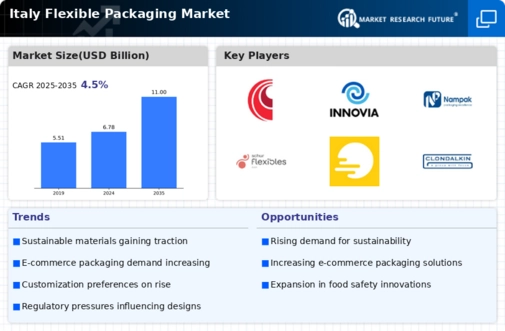Rising Demand for Convenience
The flexible packaging market in Italy experiences a notable surge in demand for convenience-oriented products. Consumers increasingly favor packaging solutions that offer ease of use, portability, and resealability. This trend is particularly evident in sectors such as food and beverages, where ready-to-eat meals and snack items are gaining traction. According to recent data, the convenience food segment has seen a growth rate of approximately 5% annually, driving the need for innovative flexible packaging solutions. As manufacturers respond to this consumer preference, the flexible packaging market is likely to expand, with companies investing in designs that enhance user experience while maintaining product integrity.
Growth of the Food and Beverage Sector
The flexible packaging market in Italy is significantly influenced by the robust growth of the food and beverage sector. With an increasing number of food products being packaged in flexible formats, the market is poised for expansion. Recent statistics indicate that the food and beverage industry contributes approximately 15% to Italy's GDP, highlighting its importance. This growth is accompanied by a rising demand for packaging that preserves freshness and extends shelf life. Consequently, the flexible packaging market is likely to see innovations in materials and technologies that cater to these needs, potentially resulting in a market growth of around 6% in the coming years.
Technological Innovations in Packaging
Technological advancements play a crucial role in shaping the flexible packaging market in Italy. Innovations such as smart packaging, which incorporates sensors to monitor product freshness, are gaining traction. These technologies not only enhance consumer experience but also improve supply chain efficiency. The flexible packaging market is witnessing investments in advanced printing techniques and materials that offer better barrier properties and customization options. As companies adopt these technologies, they may experience a competitive edge, leading to an estimated market growth of 5% over the next few years. This trend suggests a shift towards more intelligent and responsive packaging solutions.
E-commerce Growth and Packaging Adaptation
The rise of e-commerce in Italy has a profound impact on the flexible packaging market. As online shopping continues to grow, there is an increasing need for packaging that can withstand the rigors of shipping while ensuring product safety. Flexible packaging solutions are particularly well-suited for this purpose, as they are lightweight and can be designed to minimize waste. The flexible packaging market is adapting to these demands by developing packaging that not only protects products during transit but also enhances the unboxing experience for consumers. This adaptation is likely to contribute to a market growth rate of approximately 7% in the near future.
Regulatory Support for Sustainable Practices
In Italy, the flexible packaging market benefits from a regulatory environment that increasingly supports sustainable practices. The government has implemented various initiatives aimed at reducing plastic waste and promoting recycling. For instance, the introduction of extended producer responsibility (EPR) schemes encourages manufacturers to adopt eco-friendly packaging solutions. This regulatory framework not only aligns with consumer preferences for sustainability but also incentivizes innovation within the flexible packaging market. As a result, companies are likely to invest in biodegradable and recyclable materials, potentially leading to a market growth rate of 4% over the next few years.





















Leave a Comment